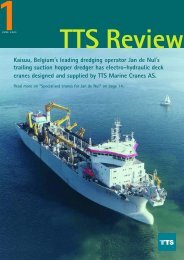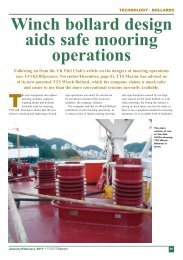Integral tank linkspan - TTS Group ASA
Integral tank linkspan - TTS Group ASA
Integral tank linkspan - TTS Group ASA
You also want an ePaper? Increase the reach of your titles
YUMPU automatically turns print PDFs into web optimized ePapers that Google loves.
POWER TO MOVE<br />
www.ttsgroup.com<br />
<strong>Integral</strong> <strong>tank</strong> <strong>linkspan</strong><br />
The first integral <strong>tank</strong> <strong>linkspan</strong> was developed in 1989 and installed on the<br />
Tees, UK. The integral <strong>tank</strong> <strong>linkspan</strong> offers the greatest stability and flexibility in<br />
accommodating vessels that are unrestricted in their beam, freeboard and ramp<br />
configuration. With the use of <strong>TTS</strong>’ integral <strong>tank</strong> <strong>linkspan</strong> structure the revenue<br />
generated by a RoRo berth can be maximised and the need for the involvement of<br />
port management reduced.<br />
PORT AND LOGISTICS
INTEGRAL TANK LINKSPAN<br />
Both the gradient and the<br />
transition angles can be<br />
specifically designed for any<br />
location, enabling the structure<br />
to be tailored to significantly<br />
reduce turnaround times. The<br />
integral <strong>tank</strong> <strong>linkspan</strong>, with no<br />
permanent support structure or<br />
portal at its outer end provides<br />
a clear, safe smooth transition<br />
between quay and ship.<br />
Many integral <strong>tank</strong> <strong>linkspan</strong>s<br />
have been installed around<br />
the world, <strong>TTS</strong> having<br />
designed and supplied a good<br />
proportion of these, all of<br />
which meet the customers’<br />
required performance and<br />
safety criteria.<br />
The integral <strong>tank</strong> <strong>linkspan</strong><br />
is supported at its widened<br />
outer end by a floating section<br />
that is part of the bridge<br />
structure. This section is deep<br />
enough to float at a level to<br />
match the freeboard of the<br />
vessel using it. The level is<br />
adjusted by a simple but rapid<br />
ballast system. The floating<br />
<strong>TTS</strong> Port Equipment AB<br />
Kämpegatan 3<br />
SE-411 04 Göteborg<br />
Sweden<br />
Tel: +46 31 725 79 00<br />
Fax: +46 31 725 78 04<br />
info@tts-port.se<br />
www.ttsgroup.com<br />
<strong>TTS</strong> Handling Systems AS<br />
Holterkollvn 6,<br />
NO-1441 Drøbak<br />
Norway<br />
Tel: +47 64 90 79 10<br />
Fax: +47 64 93 16 63<br />
info@tts-hs.no<br />
<strong>TTS</strong> Liftec Oy<br />
Sorkkalantie 394<br />
33980 Pirkkala<br />
Finland<br />
Tel: +358 3 3140 1400<br />
Fax: +358 3 3140 1444<br />
sales@tts-liftec.fi<br />
section also has a large<br />
water-plane area that limits<br />
the immersion due to traffic<br />
load to within manageable<br />
proportions.<br />
The increase in the width of<br />
the outer end also creates a<br />
large landing area onto which<br />
ship’s ramps, unrestricted<br />
in width or length, may be<br />
lowered. In addition to being<br />
able to accept all RoRo vessels<br />
regardless of their freeboard,<br />
beam or ramp size, the<br />
passage of vehicles is much<br />
smoother than with other<br />
floating types. There are only<br />
two managed articulated<br />
junctions at the hinge and<br />
at the ship’s ramp allowing<br />
the transition angles to be<br />
optimised.<br />
<strong>Integral</strong> <strong>tank</strong> <strong>linkspan</strong>s can<br />
be supplied with upper decks<br />
and in skewed configuration.<br />
Extendable flaps may also<br />
be supplied to allow use by<br />
female ships (those without<br />
ramps). These flaps stow flush<br />
with the deck, so as not to<br />
interfere with the ramp of any<br />
other ship using the berth.<br />
PORT AND LOGISTICS


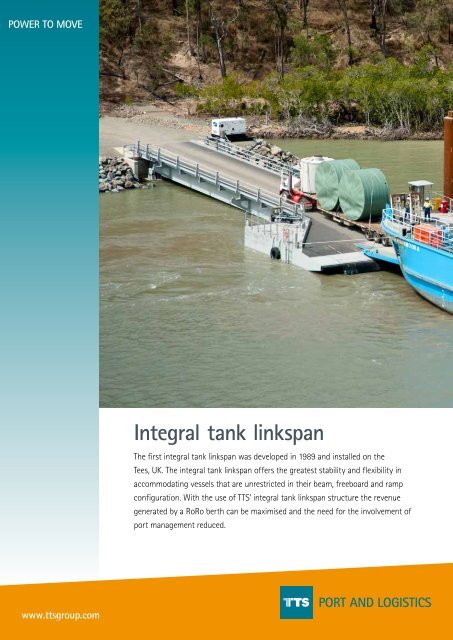


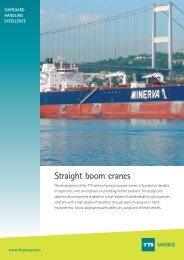
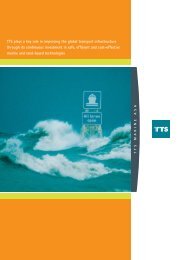
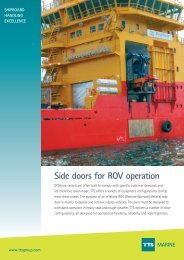
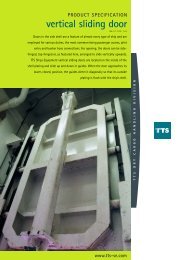
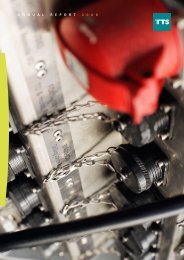
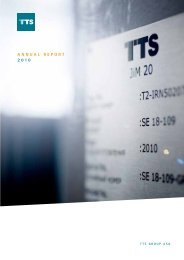
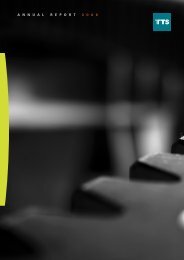
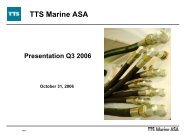
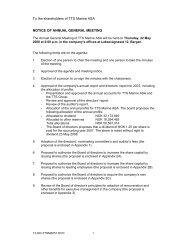
![2012.MasterPresentation_final [Compatibility Mode] - TTS Group ASA](https://img.yumpu.com/4612021/1/190x146/2012masterpresentation-final-compatibility-mode-tts-group-asa.jpg?quality=85)
